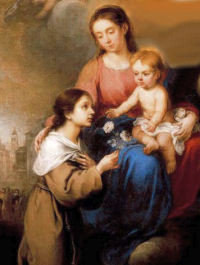St. Rosalia
St. Rosalia
 St. Rosalia is the patroness of Palermo, and the citizens of that place annually celebrate two feasts in her honour. One of these was raised to the rank of a holy day of obligation by Pius XI in 1927. It is celebrated by a procession of unequalled magnificence, heralded by cannon fire. The saint’s shrine, atop a gigantic carriage filled with musicians, is drawn through the town by forty mules, accompanied by prayers, hymns, and acclamations. The top of the carriage is level with the roofs of the houses; fireworks are set off everywhere; the musicians blow ceaselessly on their trumpets; and for the five days during which this celebration lasts, enthusiasm mounts to an increasingly high pitch.
St. Rosalia is the patroness of Palermo, and the citizens of that place annually celebrate two feasts in her honour. One of these was raised to the rank of a holy day of obligation by Pius XI in 1927. It is celebrated by a procession of unequalled magnificence, heralded by cannon fire. The saint’s shrine, atop a gigantic carriage filled with musicians, is drawn through the town by forty mules, accompanied by prayers, hymns, and acclamations. The top of the carriage is level with the roofs of the houses; fireworks are set off everywhere; the musicians blow ceaselessly on their trumpets; and for the five days during which this celebration lasts, enthusiasm mounts to an increasingly high pitch.
The saint of Palermo thus honoured, seems to have delivered her country from the plague in 1625 and, since then, to have brought about innumerable cures. Her legend states that she was born around 1130 at the court of Roger II, king of Sicily, of a father called Sinibald, who was descended from Charlemagne. As her beauty constituted a danger to her soul, the Virgin appeared to her to urge her to leave the world. Rosalia was just fourteen. She took her crucifix, her discipline, and a few books and left her father’s castle by night. Two angels, one armed like a knight, the other disguised as a pilgrim, were waiting to escort her to the summit of Mount Quisquita. There they left her at the entrance of a grotto hidden among the trees, buried under the snow. The young girl remained hidden there several months, after which the angels came to warn her that she was sought by her parents and had better flee elsewhere. They led her to the top of Mount Pellegrino. There, it is said, Rosalia, devoting herself to penances and miraculously nourished by the Host, passed the last sixteen years of her life. She died at the age of thirty; her body, long sought in vain, was found in the 17th century encased in a sheath of rock crystal; and it is the recovery of this relic which is commemorated by the procession mentioned above.
— Excerpted from Lives of the Saints, Omer Englebert
Mass Readings September 4th. , 2020